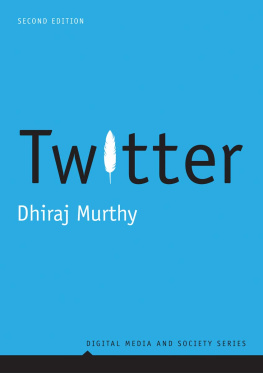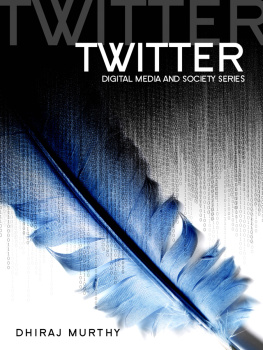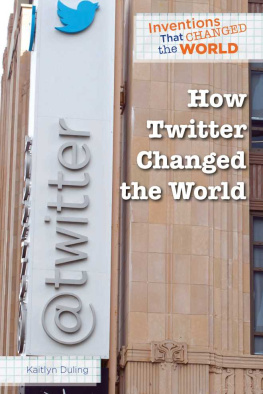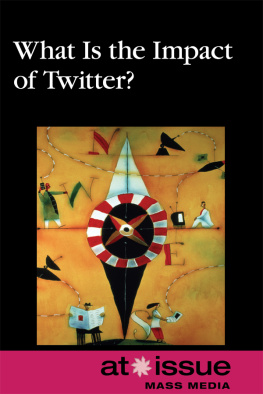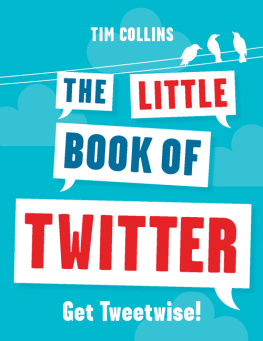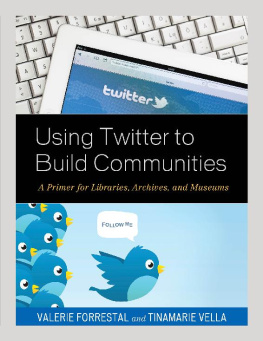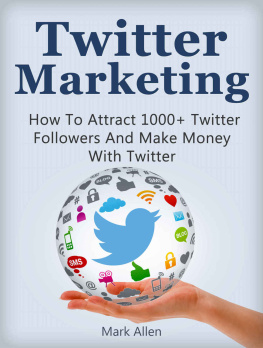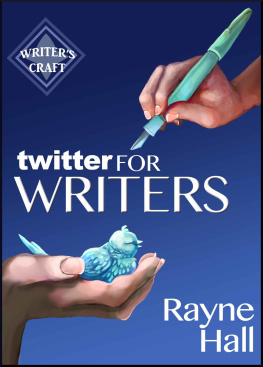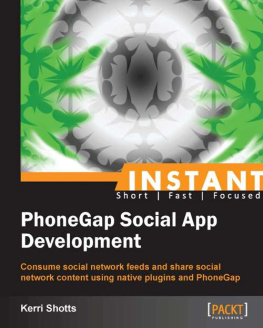Contents
List of Figures
List of Tables
Guide
Pages

Digital Media and Society Series
Nancy Baym, Personal Connections in the Digital Age, 2nd edition
Jean Burgess and Joshua Green, YouTube
Mercedes Bunz and Graham Meikle, The Internet of Things
Mark Deuze, Media Work
Andrew Dubber, Radio in the Digital Age
Charles Ess, Digital Media Ethics, 2nd edition
Jordan Frith, Smartphones as Locative Media
Alexander Halavais, Search Engine Society, 2nd edition
Martin Hand, Ubiquitous Photography
Robert Hassan, The Information Society
Tim Jordan, Hacking
Graeme Kirkpatrick, Computer Games and the Social Imaginary
Leah A. Lievrouw, Alternative and Activist New Media
Rich Ling and Jonathan Donner, Mobile Communication
Donald Matheson and Stuart Allan, Digital War Reporting
Dhiraj Murthy, Twitter, 2nd edition
Jill Walker Rettberg, Blogging, 2nd edition
Patrik Wikstrm, The Music Industry, 2nd edition
Zizi A. Papacharissi, A Private Sphere: Democracy in a Digital Age
Twitter
Social Communication in the Twitter Age
Second Edition
DHIRAJ MURTHY
polity
Copyright Dhiraj Murthy 2018
The right of Dhiraj Murthy to be identified as Author of this Work has been asserted in accordance with the UK Copyright, Designs and Patents Act 1988.
First edition published in 2013 by Polity Press
This second edition first published in 2018 by Polity Press
Polity Press
65 Bridge Street
Cambridge CB2 1UR, UK
Polity Press
101 Station Landing, Suite 300
Medford, MA 02155, USA
All rights reserved. Except for the quotation of short passages for the purpose of criticism and review, no part of this publication may be reproduced, stored in a retrieval system or transmitted, in any form or by any means, electronic, mechanical, photocopying, recording or otherwise, without the prior permission of the publisher.
ISBN-13: 978-1-5095-1253-9
A catalogue record for this book is available from the British Library.
Library of Congress Cataloging-in-Publication Data
Names: Murthy, Dhiraj, author.
Title: Twitter : social communication in the twitter age / Dhiraj Murthy. Description: Second Edition. | Medford, MA : Polity Press, [2017] | Series: Digital media and society | Revised edition of the authors Twitter, 2013. | Includes bibliographical references and index.
Identifiers: LCCN 2017031442 (print) | LCCN 2017031887 (ebook) | ISBN 9781509512539 (Epub) | ISBN 9781509512492 (hardback) | ISBN 9781509512508 (pbk.)
Subjects: LCSH: Twitter. | Online social networks.
Classification: LCC HM743.T95 (ebook) | LCC HM743.T95 M87 2017 (print) | DDC 006.7/54--dc23
LC record available at https://lccn.loc.gov/2017031442
The publisher has used its best endeavours to ensure that the URLs for external websites referred to in this book are correct and active at the time of going to press. However, the publisher has no responsibility for the websites and can make no guarantee that a site will remain live or that the content is or will remain appropriate.
Every effort has been made to trace all copyright holders, but if any have been inadvertently overlooked the publisher will be pleased to include any necessary credits in any subsequent reprint or edition.
For further information on Polity, visit our website: politybooks.com
For Kalpana, Deya Anjali, and Akash
Dedicated in loving memory of Nagavenamma and Venkatachala Shetty
Youre not reducing face-to-face time You dont choose to stay in and do Twitter. Its like those spare moments on the Web when Im doing another task I switch over to Twitter for literally 15 seconds. There is no fewer face-to-face, no fewer phone calls, theres more awareness of other people in my life and maybe that even leads to further conversation with some people.
Evan Williams, co-founder of Twitter
(cited in Niedzviecki 2009: 132)
Preface and Acknowledgments
What Hath God Wrought Samuel Morses first message, on May 24, 1844, on the newly completed telegraph wire linking Baltimore and Washington was a mere 21 characters long. Alexander Graham Bells first message on the telephone to his lab assistant on March 10, 1876, Mr Watson come here I want to see you, was more liberal: 42 characters long. And 95 years later, Ray Tomlinson sent the first email, with the message QWERTYUIOP, from one computer in Cambridge, Massachusetts, to another computer sitting beside it. Tomlinsons message: a spartan 10 characters.
In the past, technology determined the length and duration of the message. In the internet age of today, our ability to communicate is seemingly limitless. But the computer has ushered in a new era of brevity. Twitter is a digital throwback to the analog succinctness of telegrams. Yet what is the significance of this electronically diminished turn to terseness? Does it signal the dumbing down of society, the victory of short attention spans, or the rise of new virtual me cultures? Are we saying more with less, or just saying less? Or perhaps we are saying more about less. This position is well illustrated by status updates, short one- or two-line messages on the popular social networking platform Facebook. Though these short messages are often trivially banal (e.g., mustard dripping out of my bagel sandwich), they are elevated to news, which Facebook automatically distributes to your group of friends, selected individuals who have access to your Facebook profile, that is, your personalized web page on the site. Once the update percolates to your friends, they have the opportunity to comment on your update, generating a rash of discussion about dripping mustard, and so on. A photo of the offending bagel sandwich might be included as well. Platforms such as Snapchat and Instagram prioritize the role of images, but brief comments remain very important to these media.
This form of curt social exchange has become the norm with messages on Twitter, the popular social media website where individuals respond to the question Whats happening? with a maximum of 140 characters. These messages, known as tweets, can be sent through the internet, mobile devices such as smartphones and tablets, and text messages. But, unlike status updates, their strict limit of 140 characters produces at best eloquently terse responses and at worst heavily truncated speech. Tweets such as gonna see flm tonite! or jimmy wil be fired l8r 2day are reflective of the latter. The first tweet on the site, just setting up my twttr (24 characters), by Jack Dorsey, the creator of Twitter, on March 21, 2006, perhaps led by example. This book emphasizes that Dorseys message, like that of Morse, was brief and, like that of Bell, was unremarkable setting up ones Twitter and asking the recipient to return.
After 11 years of 140-character tweets, Twitter decided to double this to 280 characters from November 2017. Before rolling the change out to the general public, Twitter began trialing this feature with a select group of users (Watson 2017), though initial testing suggested that only 5 per cent of the group opted to use over 140 characters in their tweets (Newton 2017). Critics (e.g., Silver 2017) argue that this will drown out Twitter timelines, compromising the platforms uniquely succinct form of social communication.
Our contemporary use of Twitter in part a social, political, and economic information network has evolved over more than a decade. So it may be some years before the impact of the 280-character expansion can be evaluated. Given that our behaviors on all social media platforms are interlinked, it may be that Twitter is answering a call for individuals to express themselves more fully, though in the context of these platforms more broadly, 280 characters is still relatively terse.

